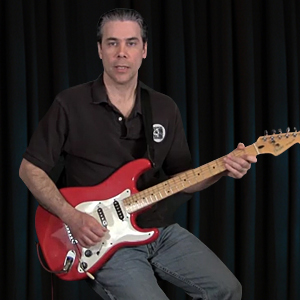Practicing Major Triads & Inversions Series 3
Description
This time we use our new concept of close harmony to further incorporate all three chord voicings we've learned thus far: root position, first inversion and second
inversion.
We start in this exercise with an A major in root position. The closest possible D major chord is a second inversion chord that shares the note A. When two consecutive chords share a note it is called a common tone. The other two notes of the chord move very minimally. One note moves up a half-step and another moves up a whole-step. Pitchwise, from low to high, we get:
C# to D - up half-step (1 fret)
E to F# - up whole-step (2 frets)
A to A - same pitch
We move back to the A major chord. Next we look for the closest possible E major chord. This happens to be the second inversion shape E major below the A major. The high note E is a common tone. The other two notes of the chord move very minimally. One note moves down a whole-step and another moves down a half-step. Pitchwise, from low to high, we get:
C# to B - down whole-step (2 frets)
E to E - same pitch
A to G# - down half-step (1 fret)
Lesson Info
Tutorial Lessons
- Introduction
- Root Position Triads
- Root Position Triads With A Backing Track
- First Inversion Triads
- First Inversion Triads With A Backing Track
- Second Inversion Triads
- Second Inversion Triads With A Backing Track
- Close Harmony Voice Motion
- Close Harmony Version 1 With A Backing Track
- Close Harmony Version 2
- Close Harmony Version 2 With A Backing Track
- Close Harmony Version 3
- Close Harmony Version 3 With A Backing Track
- Using All The Voicings!
- Using All The Voicings With A Backing Track
- Conclusion
